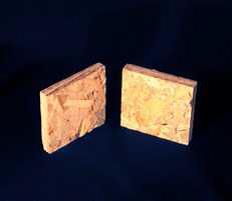Soy-Based Wood Adhesive Mussels Its Way into Oriented Strand Board
Kaichang Li, who came up with the idea t hat soy protein can be modified to perform like the proteins that allow mussels to cling unfailingly to rocks in the ocean, has found a new use for his soy-based wood adhesive. The United Soybean Board and soybean checkoff support new uses for soy by funding research and development. Li, an associate professor of wood science and engineering at Oregon State University, has received soybean checkoff support over the past three years for his project that uses soy adhesive to bond
hat soy protein can be modified to perform like the proteins that allow mussels to cling unfailingly to rocks in the ocean, has found a new use for his soy-based wood adhesive. The United Soybean Board and soybean checkoff support new uses for soy by funding research and development. Li, an associate professor of wood science and engineering at Oregon State University, has received soybean checkoff support over the past three years for his project that uses soy adhesive to bond
oriented strand board (OSB). However, the OSB project was not Li’s first experience with the soybean checkoff. Li also used the adhesive in plywood, which is now produced by Columbia Forest Products and called PureBond® (see Biobased Solutions, Jan. 2007). Now Li is nearing completion on research that uses the soy-based wood adhesive in OSB. Li said that the strengths of OSB panels bonded with the soy-based wood adhesive were comparable to or higher than those of commercial OSB panels. He hopes that the soy-based wood adhesive will eventually be used for commercial production of OSB panels.
According to Li, soy flour is an ideal raw material for making wood adhesives, as it is abundant and costs less than the petrochemicals needed to make synthetic wood adhesives such as urea-formaldehyde and phenol-formaldehyde resins.
Like PureBond, OSB bonded with the soy-based wood adhesive is virtually free of formaldehyde. According to the International Agency for Cancer Research, formaldehyde is a known carcinogen. And because the soy-based wood adhesive consists mainly of renewable soy flour, the replacement of petroleum-based synthetic wood adhesives with the soy-based adhesive will allow the end wood products to be more sustainable and more environmentally friendly.



